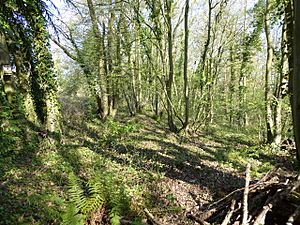Brede Pit and Cutting facts for kids
| Site of Special Scientific Interest | |
 |
|
| Area of Search | East Sussex |
|---|---|
| Interest | Geological |
| Area | 0.6 hectares (1.5 acres) |
| Notification | 1990 |
| Location map | Magic Map |
Brede Pit and Cutting is a very special place in East Sussex, England. It's officially called a Site of Special Scientific Interest (SSSI). This means it's a protected area because it has important natural features. This particular SSSI is important for its geology, which is the study of rocks and how the Earth has changed over millions of years.
Contents
What Makes Brede Pit and Cutting Special?
Brede Pit and Cutting is a small area, about the size of a football field. It's a key site for understanding the Earth's past. Scientists study the rocks here to learn about ancient environments and the creatures that lived long ago.
A Window into Ancient Earth
This site is like a natural history book made of rock. It shows us a clear "junction" or meeting point between two different rock layers. These layers are part of something called the Wealden Group. They formed during a time called the Lower Cretaceous period, which was about 145 to 100 million years ago!
Layers of Time: Formations
At Brede Pit and Cutting, you can see the top part of the Ashdown Formation. This layer is about 2 metres thick here. Right above it, you can see the bottom part of the Wadhurst Clay Formation, which is about 1.5 metres thick.
These different rock layers tell a story. The Ashdown Formation shows us a time when the area was a shallow river system. The Wadhurst Clay Formation, however, tells us that the environment changed. It became deeper, with lakes and lagoons.
Life in the Past: Fossils
Because the environment changed so much, scientists have found amazing fossils here. These fossils include ancient plants, different kinds of fish, and even reptiles! They give us clues about what life was like millions of years ago in this part of England.
Visiting Brede Pit and Cutting
It's important to know that Brede Pit and Cutting is on private land. This means there is no public access to the site. It is protected so scientists can continue to study its unique geological features.

